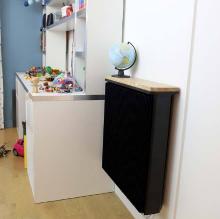We’re all familiar with our computers getting hotter and hotter as we use them. The same is true for servers in data centres. In order to keep temperatures down, data centres are cooled with air conditioning systems – which requires a huge amount of energy. In 2018 in fact, data centres in EU member states accounted for as much as 2.7 percent of total electricity consumption. With digitalisation continuing to develop, and the computer power required to power all of these new systems and devices inreasing rapidly, it’s estimated that data centres could account for 3.2 percent of electricity consumption in the EU by 2030. But this waste heat could be put to good use elsewhere – in heating.
Within the EU, a majority of the energy consumed by households – two thirds infact – is used for heating, while fossil fuels remain the dominant source of energy for heating, with gas providing around 45% of supply. Heating our homes with coal, oil and natural gas not only uses up finite resources, but also accounts for around a quarter of global greenhouse gas emissions.
Outsourcing computing power to heat offices, public housing and schools
Aiming to tackle these two issues at once, the French company Qarnot has a relatively obvious idea: turning that waste into heating for homes and other buildings. This not only makes use of an otherwise wasted resource, but also cuts down on costs and CO2 emissions. In the French cities of Montreuil, Paris and Bordeaux, the company’s radiators have already been used to heat entire social housing complexes, offices and schools.
 ©
© How it works: the radiators have high-performance computers embedded in them, that are performing complex IT operations and producing heat. So instead of water flowing through the radiatior, it’s data instead. The radiators are connected to the Internet via fiber optics. Users can instruct the computing-heaters, to compute more data, or less, to control the temperature.
Banks, 3D animation studios and other companies buy computing power from Qarnot and, instead of outsourcing it to large data centres, can outsource it to many individual radiators. The data that passes through the radiators is encrypted and not stored. So no one (including Qarnot’s developers) can access the data, let alone know what kind of data is flowing through each radiator.
After the one-time installation, the costs of the data stream heating are covered. The residents of the social housing units can heat for free with the data-powered radiators. Qarnot pays the electricity bill.
In summer, the heat is used to heat water instead. Data is being crunched by computers all year round. In order to use the waste heat in summer, the company has developed a special sort of water heater. This is used to heat water pipes with the waste heat from computers. The water can be heated to a maximum of 60°C. So it’s not a classic kettle that you use to pour your tea, but rather to heat water pipes for use in the bathroom or as part of a heating network.
Although the efficiency of data centres is increasing, the demand for computing power on the part of the users is also rising – and with it their CO2 emissions. So, as well as reusing waste heat, reducing the energy consumption of data centres and powering them with 100 percent renewable energy would also massively reduce their climate impact. As in so many other areas, however, it is up to policymakers to set the right course when it comes to regulating in this area.






